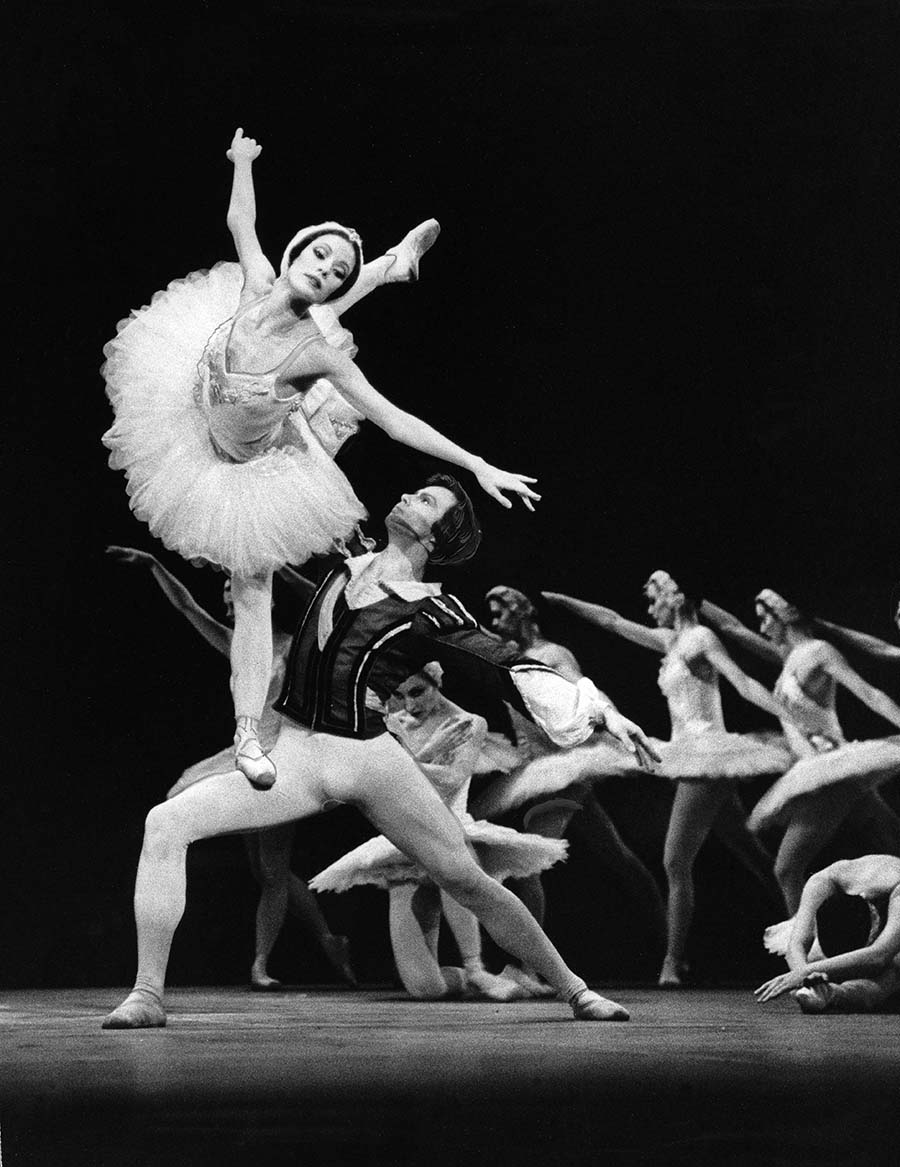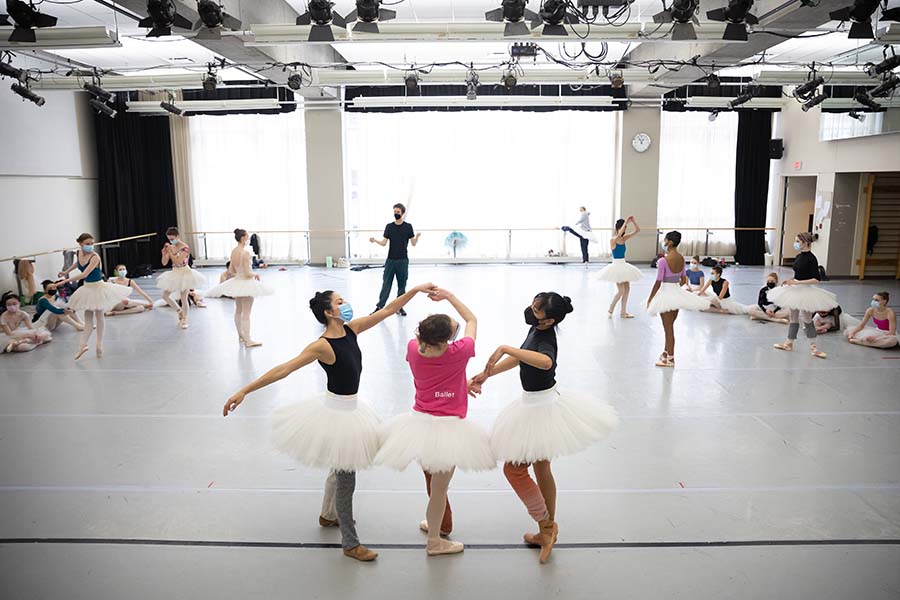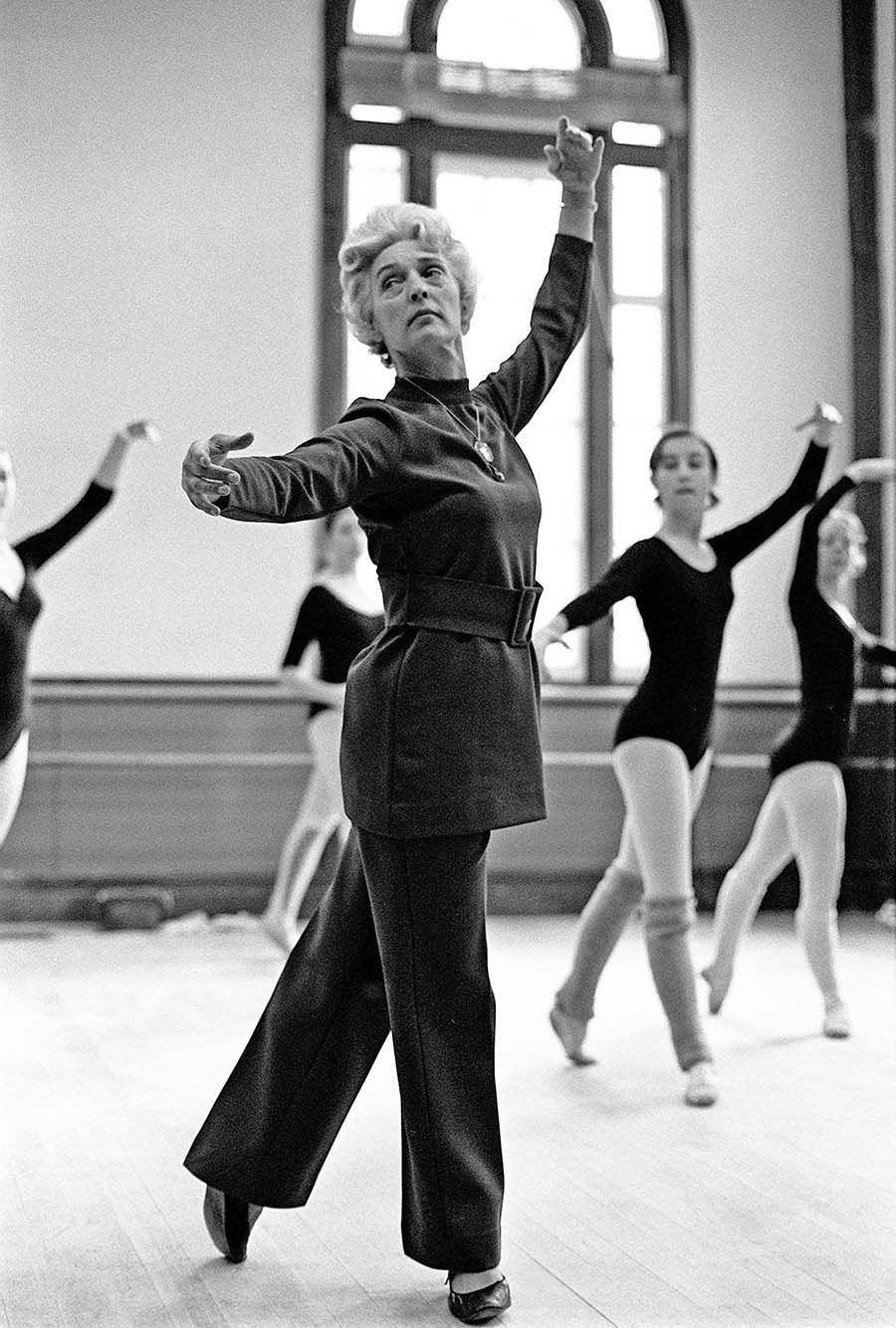Karen Kain extends one leg, her pointed toes lifting off the ground, lost in a deep focus as piano music floats through the studio.
Moments ago, she was sitting still, watching National Ballet of Canada principal dancer Tina Pereira rehearse a pas de deux for Ms. Kain’s new staging of Swan Lake. But Tchaikovsky’s music exerts a gravitational pull. From her chair, she traces Ms. Pereira’s movements, spreading her arms out and up like wings, then folding forward languidly.
“That’s coming. It’s coming,” she declares when the music pauses.
This moment has been a long time coming. These April rehearsals were supposed to have begun two years ago, before COVID-19. The National Ballet has not premiered a new Swan Lake for more than two decades. Ms. Kain’s $3-million vision of a beloved classic is a farewell for the company to which she devoted half a century’s worth of sweat and star power.

By now, Ms. Kain should be retired, with this new Swan Lake finished and ensconced in the repertoire for future seasons.
“It’s been difficult. I think I stopped believing it was ever really going to happen,” Ms. Kain says during a break between rehearsals.
In her long career, Ms. Kain ascended to a different stratum of fame from other dancers. In this, she shares something with the work she is staging: even those with little knowledge of ballet have heard of Swan Lake, and if they know any ballerina, it might be Karen Kain.
Directing Swan Lake now is a “full circle” moment, she says. The demanding dual role of the Swan Queen Odette and Black Swan Odile was her first leading part at just 19 years old. It was the first ballet she danced with Rudolf Nureyev – the beginning of a formative partnership. When she celebrated 25 years with the company, the ballet was a natural choice for her anniversary performance.

But just as dark forces lurk beyond Swan Lake’s palace walls, ill fortune has ensnared this production. (The villain of the piece, an evil sorcerer named Rothbart, only wishes he had the power to unleash a plague.)
Now back in the studio, Ms. Kain plucks a black fabric feather – Rothbart’s sinister calling card – from the floor, noting blithely how many of them seem to be lying around. “Somebody’s shedding,” associate artistic director Christopher Stowell says. She laughs and tosses the feather on a chair. With the June 10 premiere approaching, Ms. Kain is eager to move forward.


It is late February of 2020, and everything is on schedule. In the National Ballet’s wardrobe department, a “stitcher” snips feather shapes out of pleated polyester organza – a task she has repeated many times. The team has already assembled 31 swan costumes for the corps, each comprising roughly 150 handmade plumes.
“We stopped counting at 3,000,” wardrobe supervisor Stacy Dimitropoulos says.
They are now working on costumes for the six dancers tackling the role of Odette/Odile. Each downy garment takes roughly 80 hours to construct.
“We don’t get to do it often,” Ms. Dimitropoulos says of building tutus from scratch. It’s not every day that a company introduces a new staging of a full-length classical ballet. The National Ballet’s last Swan Lake was a dark and controversial staging by former artistic director James Kudelka.


Every Swan Lake descends from a 19th-century production based on a German fairy tale. It’s that old familiar yarn: boy meets girl, girl is an aquatic bird. Odette’s daily metamorphosis is part of a spell cast by Rothbart, who holds a bevy of women hostage.
At night, in human form, Odette meets Prince Siegfried. Fearing that a pure declaration of love would break his curse, Rothbart intervenes. At a palace ball, he introduces the beguiling Odile. The prince strays – either seduced by the femme fatale, or tricked into believing she is Odette, depending on the interpretation – and realizing his error, runs to the lake to beg Odette’s forgiveness.
Endings vary. In some productions, the lovers drown themselves, reuniting in a happily-ever-afterlife. In others, only one of them dies. Russia’s renowned Mariinsky Ballet, in an unusually cheery version, has the prince vanquish the bad guy.
Ms. Kain has seen many interpretations.
“None of them touched me like this one,” she says of the 1967 production by Erik Bruhn, the Danish danseur noble and former National Ballet artistic director. Mr. Bruhn’s is the inspiration for her Swan Lake, and is close to her heart. It was the first version she ever saw, and the one in which she made her debut. For many years, it has been in the vault.
“This was a very special production created for this company by one of the greatest artists that ever lived, and we lost it,” she says. “So I wanted to bring it back.”
Ms. Kain is preserving some of Mr. Bruhn’s signature choreography, such as his Black Swan pas de deux. Like most Swan Lakes, hers also draws on elements from the 1895 version by ballet masters Marius Petipa and Lev Ivanov, including the White Swan pas de deux – “you don’t mess with that” – and Odile’s fouetté turns, 32 in a row, executed while balancing on one leg. It’s a wickedly demanding feat that audiences wait for, and that gave Ms. Kain trouble. “I could probably count on one hand the number of times I managed 32, in hundreds of performances,” she says, laughing.
But much about this Swan Lake will be distinctly hers.
Chiefly, Ms. Kain wants to emphasize the humanity of Rothbart’s hostages. Even though they transform into swans by day, she makes a point of calling them “captured women.” In reworking these sections for the corps, choreographic associate Robert Binet instructs the dancers to relate to each other in a human way, leaning on a companion’s shoulder or comforting Odette with an embrace.
“They are young women who have been abducted, who have been forced to dress a certain way … because of Rothbart’s – whatever gets him off,” Ms. Kain says. “I want the audience to not just feel that they’re beautiful dancers standing in gorgeous lines and white tutus, but that there are beating hearts in those tutus, and they’re looking out for each other, and they’re terrified.”
This vision resonates with Czech-Australian set and costume designer Gabriela Tylesova.


“Karen was really interested in the darkness,” Ms. Tylesova says. In her design, Rothbart’s creeping influence is communicated in the twiglike pattern in his costume that recurs in brush strokes in the set and on his captives’ bodices. “Rothbart represents the evil in the world. … So it’s not just a fairy tale, but it’s actually this danger, possibly looming.”
During this working trip to Toronto, the designer’s schedule is packed. But tonight, she is going to the ballet. It is March 4, 2020. Unbeknownst to Ms. Tylesova, it will be her last outing to the Four Seasons Centre for some time. In nine days, the company will cancel all performances for the foreseeable future. It will be more than two years before she makes another visit to Canada.



After the global pandemic grinds the world to a halt, the National Ballet loses millions in box-office revenue. Employees take pay cuts. Dancers attempt to stay in shape while stuck at home. “I felt like I didn’t know who I was any more,” principal dancer Harrison James says of this time. “Maybe my life wasn’t balanced enough – but I didn’t have ballet.”
Work on Swan Lake is suspended. Ms. Kain is disheartened, but the enforced hiatus also has its benefits. Since retiring from dancing in 1997, she has continued working for the National Ballet, and was named artistic director in 2005. “I’ve never had time to myself, and with my family, with my husband,” she says, drawing out that last word dreamily. “Like, never! You know?”
But there is still work to do. Ms. Kain defers her retirement to help the company navigate the crisis. As lockdowns drag on, they launch fundraising drives and film performances for release online.
That “digital season” is an important motivator for principal dancer Jurgita Dronina. After having a baby in February of 2021, she sets a goal to recover in time for a planned filming of the Black Swan pas de deux. She trains while her son sleeps, holding on to his crib as a barre. She studies an old video of Ms. Kain dancing in Mr. Bruhn’s production. Seven weeks after giving birth, she is ready. Then another pandemic wave hits. The video is scrapped.
Unable to travel, Ms. Tylesova confers with the wardrobe team over WhatsApp. Resident cutter Christine Audet decorates tutus in her basement.
Working from home is not an option for set building, however.
“It’s a relief to see things moving again,” director of production Barney Bayliss said in late October of 2021. At the company’s facility in Toronto’s east end, a pair of massive black wings, each 26 feet wide, are spread out on the floor to be painted by hand. Set on an aluminum frame, they will cover the entire proscenium when closed, swinging up and out to reveal the stage.



The dancers also resume work in the fall, but COVID-19 sabotages their return to the theatre. In December, the Ontario government’s renewed capacity restrictions cut The Nutcracker’s audiences in half. Days later, the entire run is cancelled when cases emerge in the cast and orchestra.
After a much smoother spring season in March of this year, rehearsals for Swan Lake finally begin in earnest. As of this point, many dancers have yet to learn a single step.
As a girl, Ms. Kain’s talent and musicality were evident. But with four kids, her parents could not afford to send her to the National Ballet School. The school’s co-founder, Betty Oliphant, secured a partial scholarship for the 11-year-old to pursue her training. For a 1969 class graduation performance, Oliphant had her perform a piece as the Swan Queen.


After Ms. Kain joined the National Ballet, then artistic director Celia Franca would tap her for the same part, this time on a professional stage. To hear Ms. Kain tell it, at the time she still lacked both the technique and stamina needed to pull it off. But with principal dancer Veronica Tennant sidelined by an injury, Ms. Franca was suddenly short one lead for an upcoming U.S. tour. It would be the first of many Swan Lakes for Ms. Kain.
For her staging, she has introduced a pair of new characters, the prince’s sisters. Audiences who look for them in the program will find two familiar names: Elizabeth and Celia. It is a quiet tribute to the women – who were both tough on her, Ms. Kain recalls, but also saw something in her.
“They pushed me, and they showed me that I had a path.”


She had timing, too: Ms. Kain’s rise coincided with a ballet boom in the 1970s and ’80s, when public interest in dance was growing. After a young Ms. Kain and partner Frank Augustyn wowed the discerning Russian audience at a 1973 competition in Moscow, the press dubbed them the “Gold Dust Twins.”
Mr. Nureyev was attracting unprecedented attention to the National Ballet through guest appearances dancing with the company, and by bringing his staging of The Sleeping Beauty to Canada. The legendary Russian dancer nurtured Ms. Kain’s talents, boosted her then-fragile confidence and invited her to appear with him on stages around the world. In her 1994 autobiography, Ms. Kain wrote that her partnership with Mr. Nureyev pushed her beyond what she had thought were the limits of her capabilities.
But for all the limelight and gold dust, Ms. Kain also witnessed the company’s financial crises first-hand. As artistic director, she made it her mission to build up an endowment for the National Ballet, personally canvassing benefactors for support. The endowment now sits at more than $100-million. Gone are the days when board members mortgaged their homes to pay for The Sleeping Beauty.
With so much time consumed by fundraising, Ms. Kain rarely had the chance to be in the studio. It’s one reason she had never directed a ballet before. “I’m loving having quiet moments with some of the dancers, where we work on details and we talk about things,” she says.
At a rehearsal this May, she coaches ballerina Svetlana Lunkina on a moment when the villain breaks up her meeting with the prince. Ms. Kain reaches for Ms. Lunkina’s partner. “And then it’s like, you can’t, you just can’t,” she says, pulling away as though an invisible force has grasped her by the waist. Ms. Lunkina tries it again, despair crossing her face as she is dragged slowly backward under Rothbart’s power.
Ms. Dronina, who has danced in nine versions of Swan Lake, appreciates the human emphasis Ms. Kain has placed on Odette’s character – not least because she has always struggled with productions where the Siegfried is supposedly falling in love with a “flapping bird.”


Ms. Kain has chosen to preserve the psychological depth Mr. Bruhn gave to the prince, including in a first-act solo conveying his loneliness. “It’s easy to look at a lot of the princes in ballets and see them as not very intelligent,” says Harrison James, who will make his debut in the role in June. “ … In this version, they want to give Siegfried more nuance.”
This ballet is such a reliable box-office draw that choreographer and New York City Ballet co-founder George Balanchine once joked that all ballets should be called Swan Lake. If Ms. Kain’s production is a success with audiences, it will likely be in heavy rotation, appearing every three to five years.
But as artistic director, Ms. Kain did not just rely on beloved classics. She also acquired new work, from choreographers such as Alexei Ratmansky, Wayne McGregor and Canadian phenom Crystal Pite. And she promoted choreography from within the company, such as from Guillaume Côté and Alysa Pires.
“That’s how you develop your audience’s taste, you expose them to all the different points of view in dance … and I know some of our patrons love it, some of them don’t, or they have their favourites,” Ms. Kain says, adding that a broad repertoire is important for attracting the best dancers.
Her successor, artistic director Hope Muir, plans to carry on that balanced approach, and hopes Swan Lake will be part of that as a “signature piece” for years to come. “It’s a company that has always remembered where it has come from,” she says. “And I think it’s really important for the future of the National Ballet.”
Back in the studio this spring, Ms. Kain sighs happily. She huddles around an iPad with former principal dancer and now artist-in-residence Rex Harrington, and principals Ms. Pereira and Naoya Ebe. “Ahh, we’re in love!” Ms. Kain coos, as they watch a video of her and Mr. Harrington dancing the White Swan pas de deux in 1994 – her final performance in Swan Lake.
“I thought, ‘God, here we are. And it’s been all these years,’” Mr. Harrington says of rewatching the footage. Their 40-year relationship has had its ups and downs, but separately, both say this time working together has reminded them how special their connection is.
“Even standing there marking it, I look in the mirror, and I’m tearing up almost. It’s so – and I’m going to cry now,” Mr. Harrington says, his voice breaking. “It’s so emotional, to come full circle.”
In just a few weeks, Ms. Kain will take her leave. She is not cutting ties: the company may call on her for counsel, or to make appearances as artistic director emerita. Whenever The Sleeping Beauty or Swan Lake return, she will likely oversee rehearsals. But after spending most of her life consumed by ballet, working with a dancer’s discipline, she is ready for a break.
“You did something beautiful there,” Ms. Pereira says when they pause the video, trying to translate a movement with her own body.
“Karen will show you,” Mr. Harrington says, beckoning Ms. Kain to join him.
“I don’t know how much I’ll remember,” Ms. Kain says.
“You’ll be fine,” Mr. Harrington replies in an affectionately bossy tone.

They begin walking through the steps, at times a little uncertainly, as they clarify the direction of a turn here, or squabble amiably about whether she does a bourrée there. Ms. Pereira and Mr. Ebe follow along. Ms. Kain’s arms glide through the air, the movement lodged deep in her muscle memory. Clasping one of her hands tenderly, and then the other, her old partner folds her into an embrace and they sway gently. The end will come. The lovers will part: Odette and her prince, Ms. Kain and ballet.
But not just yet.



From the archives
Explore how The Globe covered Karen Kain’s early performances in Swan Lake since the beginning of her career in the 70s.




 Susan Krashinsky Robertson
Susan Krashinsky Robertson